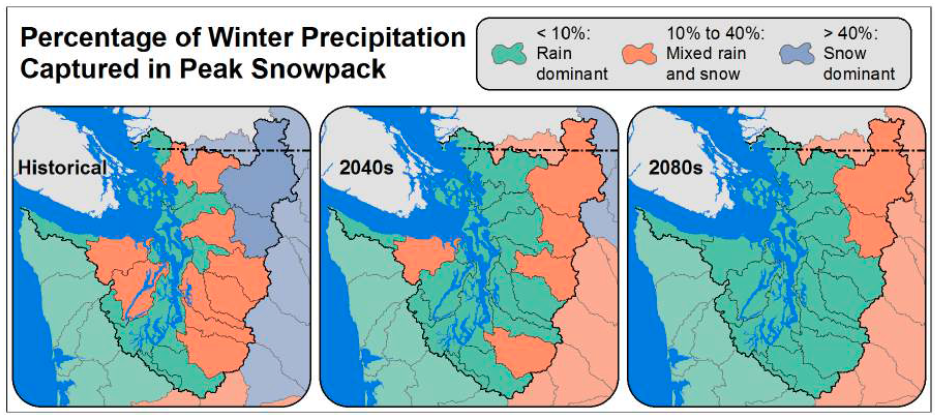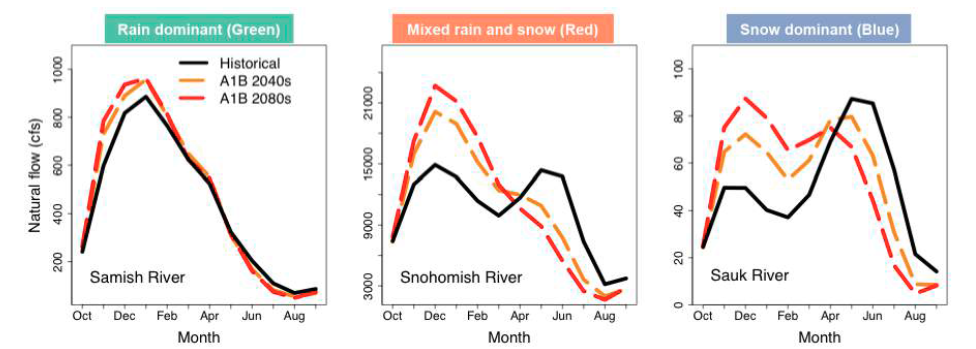A New Synthesis Report on Climate Change in the Puget Sound
A new state of the knowledge report from the University of Washington’s Climate Impacts Group on climate change in the Puget Sound region was released in November (Mauger et al. 2015). A wide range of topics is covered in the report with separate chapters describing how climate change is expected to impact each topic area (e.g., agriculture, human health, sea level, water quality, and ecosystems, among others). The report is specific to the Puget Sound region, which is defined as the Puget Sound and Straight of Juan de Fuca water bodies and all adjacent land that drains into them. Meant to be accessible by a wide audience, the jointly funded (Puget Sound Institute, NOAA, and State of Washington) report is an update to a previous report released 10 years ago. Additional topics that were not part of the previous report include expanded sections on ocean acidification and landslides, and much more detail on salmon. We will highlight just a few particulars here motivated by the 2015 drought, which has shown that our region, while notoriously wet, can sometimes have a scarcity of water. How is climate change liable to influence the nature of our precipitation events and water supplies, and what might be the impacts?
Of course a lack of water is not the only kind of problem; sometimes there is too much of a good thing. One of the specific subjects in the report (in Section 2 on the climate) relates to extreme rainfall events. There is tentative evidence from observations that there are modest increases in heavy rainfall events (48-hour and shorter in duration) in western WA, as found by Mass et al. (2011) for coastal WA locations. An in-house study carried out by the OWSC revealed that these types of events were tending to become more common in winter in western WA, but not in summer (May 2014 newsletter). To be sure, there is considerable temporal and spatial variability in these trends, and the inherently “noisy” nature of time series of extreme events complicates attribution to climate change. Nevertheless, present climate models are suggesting that heavy precipitation events will increase in magnitude (by very roughly 20% on average) and frequency (by as much as four-fold) by the 2080s relative to the latter part of the 20th century.
More extreme bursts of rainfall probably mean a greater threat of landslides. This issue is discussed in Section 5 of the report. While the connection between heavy rain and higher soil moisture contents, and ultimately the failure of steep slopes, may seem obvious for low-elevation locations such as bluffs along the shores of Puget Sound, the report also discusses how there is also an increasing threat at higher elevations. A direct effect here will be the warming associated with climate change and hence a greater proportion of rain relative to snow, compared with the present climate. In addition, snowpack serves to slow the infiltration of water into the soil and prevent the erosion caused by pounding rains and hence limit (but not prevent) landslides at higher elevations during the cold season. The effects of heavier rains, and more rain in the mountains, on landslides in the Puget Sound region with the changing climate can either be mitigated or exacerbated by concomitant changes in land use and land cover.
Warming temperatures will almost certainly lead to changes in the timing of streamflow in many area rivers. Western WA has three basic types of rivers: rain-dominant, “transient”, and snow-dominant. Low-elevation watersheds will continue to receive the vast majority of their precipitation as rain, with both average and peak flows remaining generally highest in winter during the wet season. Transient rivers, which now experience high flows in winter (especially during periods of warm, wet weather) and spring (due to snowmelt) will undergo a transition to seasonal cycles of present rain-dominant streams. And the hydrographs of present snow-dominant rivers, such as the Sauk and upper Skagit, are apt to resemble those of present transient rivers. The reproductions of Figures 3-1 and 3-2 from the report included here (Figures 1 and 2) illustrate these changes in streamflow that are expected in future decades.

We note above that actions can be taken to ameliorate the effects of climate change on the Puget Sound region. The report notes many examples of organizations collaborating with others and preparing for the impacts of climate change, with some preparedness activities already taking place. One such example of adaptation that has been implemented is the newly renovated ($65 million) water treatment plant for the City of Anacortes, completed in 2013. The plant sits on the Skagit River and is responsible for the drinking water supply for about 56,000 residential, commercial, and industrial customers. Climate change projections indicate increased flooding and sediment on the Skagit River, and these projections were taken into account for the new design, with a more effective sediment removal process included. In addition, all electrical controls were moved well above the current 100-year flood levels and other structures were elevated. The new synthesis report should help motivate and guide new efforts of this type, and we recommend further reading of the report and this Seattle Times article for more information.

References:
Mass, C., A. Skalenakis, and M. Warner, 2011. Extreme precipitation over the west coast of North America: Is there a trend? J. Hydrometeor., 12, 310-318.
Mauger, G.S., J.H. Casola, H.A. Morgan, R.L. Strauch, B. Jones, B. Curry, T.M. Busch Isaksen, L. Whitely Binder, M.B. Krosby, A.K. Snover, 2015. State of Knowledge: Climate
Change in Puget Sound. Report prepared for the Puget Sound Partnership and NOAA. Climate Impacts Group, University of Washington, Seattle. doi:10.7915/CIG93777D Report available online: https://cig.uw.edu/resources/special-reports/ps-sok/